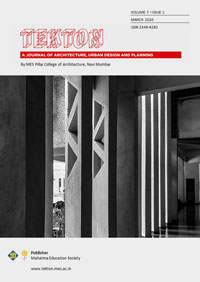Bhagyasshree Ramakrishna
Tekton
Volume 7, Issue 1, March 2020
pp. 18 – 32
 Bhagyasshree Ramakrishna is an architect-urban designer and holds a Master’s Degree in Urban Design from CEPT University (2018). She pursued her independent research project semester with Politecnico di Milano University, Italy. She has since been involved in urban design and architectural projects and is currently a visiting professor in the Bachelors of Urban Design, Faculty of Planning at CEPT University. She is keen on expanding her research on conscious urban design practices and management.
Bhagyasshree Ramakrishna is an architect-urban designer and holds a Master’s Degree in Urban Design from CEPT University (2018). She pursued her independent research project semester with Politecnico di Milano University, Italy. She has since been involved in urban design and architectural projects and is currently a visiting professor in the Bachelors of Urban Design, Faculty of Planning at CEPT University. She is keen on expanding her research on conscious urban design practices and management.
bhagyasshree1@gmail.com
ABSTRACT
The deindustrialization process in Europe resulted in many large-scale factories to be shifted out of their city-limits and aimed to redevelop cities as centers of creative productions. In Milan, Italy, this process left distinct voids in its urban fabric due to its defined urban morphology and separation from its heritage core. The process of re-adapting this industrial infrastructure into sites of innovation resulted in a new typology of public space. The juxtaposition of the two notions of public spaces; the traditional, mixed-uses at the heritage core and the institutional industrial districts called for integration strategies to be formulated at a city-scale. The paper analyses Lambrate Industrial Design District as a model for adapting public functions within its built forms, inclusive creative networking at a city-scale and sustaining local micro-businesses. The transformations include maintaining the structural integrity of the industrial morphology as a key to conserve its industrial past. At a city-scale, vacant pockets allow for flexibility in the master plan that caters to the inclusive needs of cities in constant flux.
KEY WORDS
Industrial Design Districts, Urban Regeneration, Public Space, Urban Identity, Milan


